 Catharine Beecher and Harriet Beecher
Stowe’s ideal stove design, from The New Housekeeper’s Manual,1873.
Catharine Beecher and Harriet Beecher
Stowe’s ideal stove design, from The New Housekeeper’s Manual,1873.The prevention of illness through exercise and nutrition was an outgrowth of quackery medicine. It was a small step from movements like hydropathy which advocated the "natural" healing powers of water to the idea that fresh air, healthy food, and exercise could be beneficial.
Catharine Beecher noted a connection between poor air quality in European slums and the spread of disease. She advocated open fireplaces and improved home ventilation, stating the "first and most indispensable requisite for health is pure air, both by day and night." She felt windows should be kept open and bed chambers kept cold to improve resistance to disease. She researched cooking and heating stove design, and strongly opposed closed furnaces because they removed moisture from the air and could leak poisonous gases. Other advocates for clean air included William Alcott, who wanted to change the architecture of school houses to improve ventilation and add outside playgrounds where students could breathe healthful air.
The physical fitness movement in the United States followed the influx of a large number of German immigrants who fled their country due to the 1848 revolution. The movement began there with Fredrich Ludwig Jahn (1778–1852), who unified exercise and sport with German history and tradition and saw a connection between mental and physical health. Charles Follen, a Jahn student and author of Die deutshe Turnkeise, led the movement in America, organizing the Round Hill School at Harvard which stressed rigorous mental and physical exercise. Training included carefully organized and militaristic calisthenics drills. In the midwest, the Germans established their first gymnastic institution called the Turnverein in Cincinnati in 1848. Later called the Turners, these groups developed nationally and organized outings of picnics, games, gymnastics, and celebrations of German culture.
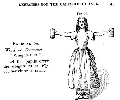 Exercises for women as proposed by
Catherine Beecher, 1856.
Exercises for women as proposed by
Catherine Beecher, 1856.
Catharine Beecher promoted physical fitness for women. She felt corsets not only made such exercise impossible, but actually deformed women's bodies. Worst of all, such deformities, she believed, could be passed on to future generations and degrade the race. She campaigned for a school curriculum that included calisthenics, and produced instructive drawings of appropriate exercises for young men and women.
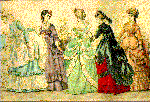 Women’s fashions of the
Victorian era demanded tight corsets.
Women’s fashions of the
Victorian era demanded tight corsets.
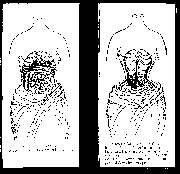 Catherine Beecher’s theory of
the effect of tight corsets on the internal organs of women.
Catherine Beecher’s theory of
the effect of tight corsets on the internal organs of women.
In the years 1830–1860, the physical fitness movement dovetailed with the evangelical movement's millennialist message of the need for action to improve the human race. Americans had a special responsibility to fulfill the promise of the Revolution and rescue civilization. Many believed the country had degenerated from the era of the great leaders of 1776, hence the democratic experiment was doomed to failure without an effort to improve physically. The increasing number of tuberculosis cases was evidence of this degeneration. The rejuvenation of Americans as individuals and the rejuvenation of the country were tied together in the millennial dream.
Catharine Beecher also advocated improving nutrition. She was an early opponent of gluttony, believing condiments on food stimulated the appetite toward excess. Mustard and hot peppers were particularly bad.
The best-known 19th century "health food" advocate was Sylvester Graham. His 1837 "Treatise on Bread Making" expounded against artificial ingredients in flours and endorsed whole grains. He championed vegetarianism because meat overstimulated the digestive tract, and he believed the optimal diet consisted of bran bread, vegetables, and water. Of course alcohol, tobacco, coffee, and tea also overstimulated, and were virulently opposed by Temperance leaders. Russell Trall, author of the Hydropathic Cook Book, even suggested liquor-laced cakes were harmful and condemned most cook books for combining spices and producing dyspepsia and constipation.
Dio Lewis, in his book Our Digestion; or, My Jolly Friend's Secret, examined other causes of stomach discomfort and found they included corsets, tomatoes, and lack of sunshine. He related most physical ailments to poor eating habits, stating "we have only one stomach, and when that fails, the whole body must fail." Lewis opposed white bread, butter, and sugar, and like Graham, favored whole grains like oatmeal, cracked wheat, and corn.
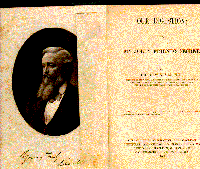 The title page to Lewis’s book
on digestion, 1872.
The title page to Lewis’s book
on digestion, 1872.
Regardless of their particular bent, all of the food reformers had a common philosophy: bad eating habits led to social disorder. Like physical fitness proponents, they saw a connection between reshaping the body and reshaping American society to improve the individual and the country.
The physical fitness movement declined in the years preceding the Civil War. But after the war, the movement revived as Americans became city dwellers and took sedentary jobs. Advocates of physical fitness after the war promoted "Muscular Christianity," a movement begun in England which stressed that the best and most moral Christians were those with sound bodies. Some even proposed that the mind could be improved through the improvement of the body, like a machine made more efficient.
Dio Lewis believed exercise important for all ages and both sexes. His exercises went beyond Catharine Beecher's by including hand-to-eye coordination drills and utilizing wooden hoops, light dumbbells, and Indian clubs. Indian clubs became a favorite exercise tool with entire books written for club exercises.
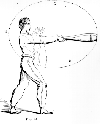 Suggestions for exercising with
Indian clubs.
Suggestions for exercising with
Indian clubs.
Team sports became popular after 1865, reflecting America's growing urbanization. The most popular was baseball. In 1869 the Cincinnati Red Stockings became the country's first professional baseball team.
By the century's end, Luther Gulick transformed the Young Men's Christian Association into the epitome of "Muscular Christianity." It became the largest organization of urban gymnasiums and fitness centers where urban youths could channel their energies into creating better bodies and minds.
Physical Fitness
Angerstein, Eduard and Gebhard Eckler. Home Gymnastics for the Well and Sick Adapted to All Ages and Both Sexes; With Directions on How to Preserve and Increase Health(translated from eighth German edition). Boston and New York: Houghton, Mifflin and Company, 1889.
Beecher, Catharine E. Physiology and Calisthenics for Schools and Families. New York: Harper & Brothers, 1856.
Porter, Luther H. Cycling for Health and Pleasure: An Indispensable Guide to the Successful Use of the Wheel. New York: Dodd, Mead and Company, 1896.
Toledo Union Schools German Instructor, "On Physical Education," letter dated February 3, 1860. Toledo Turners Records, MSS-103, Ward M. Canaday Center.
Watson, James Madison. Hand-Book of Calisthenics and Gymnastics: A Complete Drill-Book for Schools, Families, and Gymnasiums. New York: E. Steiger & Co., 1882.
 Calisthenic exercises using light
dumbbells as proposed in Watson’s book.
Calisthenic exercises using light
dumbbells as proposed in Watson’s book.
Nutrition Alcott, William A. The Young House-Keeper or Thoughts on Food and Cookery. Boston: George W. Light, 1838.
A Manual of Homeopathic Cookery, Designed Chiefly for the Use of Such Persons as are Under Homeopathic Treatment. By the Wife of a Homeopathic Physician. New York: William Radde, 1846.
Edmunds, James.Stimulants for Women: Address to Women at Association Hall, on the Use of Stimulants for Women and Nursing Mothers. New York: National Temperance Society & Publication House, 1875.
Lewis, Dio. Our Digestion; or, My Jolly Friend's Secret. Philadelphia and Boston: Geo. Maclean, 1872.
Permanent Temperance Documents of the American Temperance Society, Vol. 1. Boston: American Temperance Society, 1835.
Smith, John. Fruits and Farinacea, the Proper Food of Man; Being an Attempt to Prove from History, Anatomy, Physiology, and Chemistry that the Original, Natural, and Best Diet of Man is Derived from the Vegetable Kingdom.With Notes and Illustrations by R. T. Trall, M.D. New York: Fowler & Wells, 1854.
Stewart, Mother. Memories of the Crusade: A Thrilling Account of the Great Uprising of the Women of Ohio in 1873, Against the Liquor Crime. Columbus: William G. Hubbard & Co., 1889.
Fresh Air Movement Alcott, William A. The Laws of Health: Or, Sequel to "The House I Live In." Boston: John P. Jewett and Company, 1857.
Beecher, Catharine E., and Harriet Beecher Stowe. The New Housekeeper's Manual: Embracing a New Revised Edition of the American Woman's Home; or, Principles of Domestic Science. New York: J.B. Ford and Company, 1873.